Reflecting Student Needs
The University of Edinburgh are utilising open badges, which are awarded via Moodle, in two ways. First, as part of the course, Introduction to Digital Environments for Learning (IDEL). This course has a two-week section on open education; the first week focuses on Massive Open Online Courses (MOOC), whilst the second week looks at open digital badges. Assessment for this second week asks students to reflect and briefly blog on open badge systems with students being awarded a badge to recognise completion of the activity. Blog posts are also shared and reused as examples in future iterations of the course. For example, this piece by Stuart Nicol examines Mozilla Open Badges and their use for both non-formal and formal accreditation Peter explained how student demand for course content on open badging helped shape the open education section of IDEL, which had, as at April 2017, been through two iterations:
“Across various different modules on the programme students were asking about badges and seemed quite interested in badges, and we didn’t have anywhere on the programme where we addressed that issue…”
Open badging is used slightly differently in the second instance. In this case, a more developed badge system has been integrated into the Wider Themes in Digital Education course on the Masters since September 2016. Peter described how a portfolio style based course, offering maximum flexibility for students, “extensive scaffolding and formative feedback” and incorporating open badging was decided upon when Peter and colleagues were “discussing the really interesting work our students do … [and that students] … are not standard University of Edinburgh Masters students.”
With a learner demographic of mid-late career students ranging from educators in schools to practitioners in higher education to those working in the non-formal learning sector and corporate training, it was important to “recognis[e] that and validat[e] that kind of interest and work that they do.” Awarding badges has a dual function within the Masters. First, learners have the option to develop learning activities that, when completed, are recognised by a badge. Learners are also awarded badges for the completion of other actions such as peer assessment. Second, awarding badges for the completion of a range of actions has another purpose; it can take up to six years to complete the MSc and the Wider Themes course can be stretched across academic years. Badging offers the possibility of a “strong visual way of [learners] tracking their progress.”
Reactions to Badging
Peter reflected on using open badges as part of the introductory IDEL course:
“The students you would expect to be interested in badges have been interested in badges and really keen to collect their badge. And the students you’d expect to be less interested in badges have not been interested in getting the badge particularly. It doesn’t mean they haven’t done the task, but they’ve not been chasing up about getting the badge itself and there’s the possibility that how they treat the idea of badges in the actual blog post is perhaps different although we haven’t got enough to talk about any pattern there.”
This experience of badging being a motivator for particular learners, whilst not so much for others, resonates with existing research such as Abramovich, S., Schunn, C., & Higashi, R. M. (2013). Are badges useful in education? It depends upon the type of badge and expertise of the learner.
Within the context of the Wider Themes in Digital Education course or module of the MSc Peter described how a number of students found it difficult to create well-aligned learning activities as they “…underestimate what’s involved in thinking through a learning activity properly…” and the amount of time a task might take. Students are keen to engage with the task of creating a badged activity but take up of badges since the course launched in September is currently low with students showing little interest in showcasing badges externally. There have also been technical issues with Moodle and the Mozilla Backpack. However, despite these challenges Peter noted that even the process of engaging with the creation of badged activities provides a valuable reflection point for learners.
Thinking about Open Badging at Your Institution?
Peter had advice for anyone considering the use of open badges:
- Be clear on why you are using an open badge. Peter and his colleagues spent a lot of time discussing badging and the purpose and meaning of badges for staff, students and the University.
- What does the badge signify and what is its relationship (if any) to existing, formal accreditation at the institution? Peter again stressed the need for clarity on this point. At Edinburgh open badges are not associated with the formal accreditation system. Therefore a badge “…signifies a student has performed task X and that’s it” rather than it signifying completion of a task to a specific degree standard (which is the role of credits at the end of each module).
- Whilst badging is still work in progress and questions around whether it is “meaningful” to students remain, implementing trials of open badging such as those described above are also quicker to implement and more flexible if not connected to the formal accreditation of learning.
Openness in Education
Openness in education was described by Peter as encompassing three things: transparency in pedagogy, the use of open resources and being open to different approaches and a commitment to a more equitable way of conducting learning and teaching:
“I suppose openness … there’s a number of factors to it. One is to do with transparency, about what you’re doing. So this may be an advantage of mainly teaching in the area of education or learning in that taking time to explain what you are doing and why you are doing it. So really being open about the process of teaching, learning and assessment… is part of it. It’s using open resources as much as possible so Creative Commons wherever possible … though I am very conscious that we’re then dragging these into the closed environment of Moodle. Which causes a little bit of a cognitive dissonance and possibly more.
And also I suppose openness, for me anyway, involves being open to the challenge of how you’re doing the course or how you’re assessing it and being flexible around that. So if a student makes the argument for why they should be able to attempt the assessed task in the way they want to, that may not be the way I envisaged it and they can justify that in terms of the learning outcomes then that is something I should accept. And I do accept; it’s happened once or twice…”
Next Steps?
Peter reflected on the future of open badging at Edinburgh and, whilst an institutional position is pending, possible future uses include incorporating open badging into continuing professional development (CPD) offerings with a “less process, more outcome orientated” approach.
Originally published on 1 July 2017 - 4:16pm by Beck Pitt
Further Reading
- Peter’s blog
- Mozilla resource Is there Open Badges Research Available?
- JISC So What Are Open Badges?
Picture credits: section from sketch note of "Melissa.Highton.OER16" by Beck Pitt, licensed CC BY 2.0 and "Badges" by Jacob Munk-Stander, licensed CC BY 2.0




